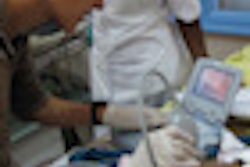Dear AuntMinnie Member,
A new study published this week in the New England Journal of Medicine indicates that low-dose CT lung screening is effective in reducing mortality rates from lung cancer by up to 20% compared to radiography-based screening.
The results, from the National Lung Screening Trial (NLST), represent one of the first studies to demonstrate a mortality benefit for CT lung screening, according to an article in our CT Digital Community. The study comes on the heels of research published earlier this week confirming the mortality benefit of mammography screening, which reduced deaths by 30% compared to results in an unscreened group of women.
The NLST data are great news for radiology advocates, but the data lead to almost as many questions as answers. Should public health authorities now set up CT lung screening programs? Would a population-based lung screening program be cost-effective? And what about the issue of false-positive findings, with associated costs and patient morbidity?
Learn more about this week's study by clicking here, or visit our CT Digital Community at ct.auntminnie.com.
Meanwhile, fallout continues from results of the Swedish Two-County Trial on mammography screening, released earlier this week. Screening advocates are using the study's findings to lobby the U.S. Preventive Services Task Force to rescind its 2009 decision to raise its recommended age for mammography screening to 50. Learn more by clicking here.
9.4-tesla PET/MRI
PET/MRI has been making headlines since the first commercial system was cleared for marketing in the U.S. earlier this month by the U.S. Food and Drug Administration. That system is based on a 3-tesla MRI scanner -- but what if you used an ultrahigh-field 9.4-tesla magnet?
German researchers shed some light on that question in an article we're featuring on our AuntMinnieEurope.com sister site. They found that the system creates new opportunities, particularly for brain imaging, but has challenges as well. Find out what they are by clicking here for a report from last week's Symposium on Ultrahigh Field Magnetic Resonance in Berlin.
Ready for a 90% utilization rate?
In other news, radiology was just getting used to a 75% utilization rate for imaging equipment when a bombshell dropped this week: The Senate is considering legislation that would raise the utilization rate even higher, to 90%.
How can this be? Well, it's a long story, but it involves a free trade agreement currently being negotiated with South Korea, one that's prompted lawmakers to try to find other areas of the federal budget to cut to offset tariff reductions -- and medical imaging is always a fat target.
Radiology advocates are fighting the proposal, but that battle will come down to the wire, and a vote is expected today. But think of the bright side: Even if your imaging reimbursement goes down, you might be able to drive a better deal on that new Hyundai Equus. Learn more by clicking here for a story in our Imaging Leaders Digital Community.
Also in the community, check out associate editor Kate Madden Yee's Leaders in Imaging interview with Dr. Gary Becker, executive director of the American Board of Radiology (ABR). In the interview, Dr. Becker explains the ABR's new crackdown on using previous test questions to prepare for board examinations.
You'll find the article by clicking here, or get both stories in our Imaging Leaders Digital Community, at leaders.auntminnie.com



















